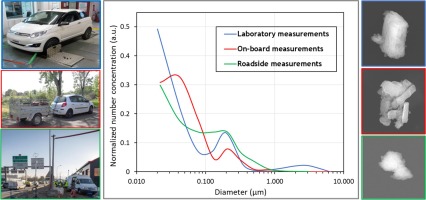Transportation Research Part D: Transport and Environment ( IF 7.3 ) Pub Date : 2020-03-04 , DOI: 10.1016/j.trd.2020.102290 A. Beji , K. Deboudt , S. Khardi , B. Muresan , P. Flament , M. Fourmentin , L. Lumière

|
Non-exhaust particle (NEP) emissions from road traffic contribute significantly to Particulate Matter (PM) pollution in urban areas. The primary objective herein is to develop the knowledge required to move toward more sustainable mobility. NEP emissions are studied by means of complementary experiments on chassis dynamometers, on test tracks and at the roadside. Laboratory tests demonstrate that brake wear particles (BWP) emissions can change with braking force and frequency. A brake pad temperature threshold exists, above which the rate of ultrafine particle emissions is quite high. Below this threshold, the BWP emissions are dominant in the accumulation and coarse modes. Test track measurements have demonstrated that tire-road contact particle (TRCP) emissions considerably modify the atmospheric PM background especially for the supermicron fraction. Their number size distribution highlighted an ultrafine and accumulation modes centered at about 40 nm and 200 nm, respectively. The TRCP level increases with vehicle speed and during the acceleration and deceleration phases. Roadside measurements in the urban environment confirm the presence of NEP in significant proportions, in both the accumulation and coarse modes. The chemical composition of NEP differs depending on the size mode: BWP mainly stem from the degradation of brake pad lining materials, while TRCP are a mixture of tire tread wear and re-suspended dust. The presence of Fe-rich particles nevertheless serves as a good indicator of the NEP contribution to PM at the roadside. Lastly, in considering the parameters influencing NEP emissions, a series of recommendations are offered in order to achieve a more sustainable mobility.
中文翻译:

各种行驶条件下的非排放颗粒物排放:对可持续出行的影响
道路交通中的非排放颗粒物(NEP)排放严重影响了城市地区的颗粒物(PM)污染。本文的主要目的是发展向更可持续的移动性发展所需的知识。NEP排放通过底盘测功机,测试轨道和路边的补充实验进行研究。实验室测试表明,制动磨损颗粒(BWP)排放会随制动力和频率而变化。存在制动衬块温度阈值,在该阈值之上,超细颗粒的排放速率非常高。低于此阈值,BWP排放在累积模式和粗模式下占主导地位。测试跟踪测量表明,轮胎-道路接触颗粒(TRCP)的排放量极大地改变了大气PM背景,尤其是对于超微颗粒而言。它们的数量大小分布突出了分别位于约40 nm和200 nm处的超细和累积模式。TRCP水平随车辆速度以及在加速和减速阶段增加。在城市环境中的路边测量结果表明,无论是累积模式还是粗糙模式,NEP的比例都很大。NEP的化学成分因尺寸模式而异:BWP主要来自制动衬片衬里材料的降解,而TRCP是轮胎胎面磨损和重新悬浮的粉尘的混合物。尽管如此,富铁颗粒的存在仍然可以很好地表明NEP对路边PM的贡献。最后,在考虑影响NEP排放的参数时,提出了一系列建议,以实现更可持续的机动性。











































 京公网安备 11010802027423号
京公网安备 11010802027423号